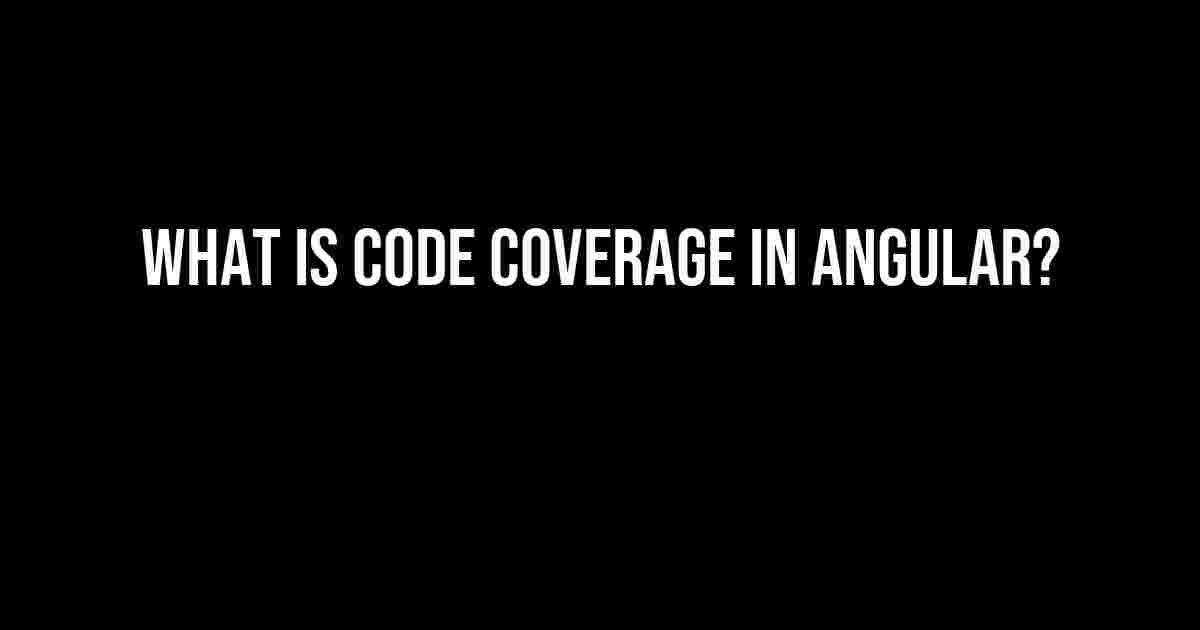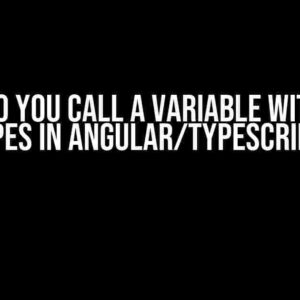Are you frustrated with the “ng test –code-coverage-exclude” command not working as expected? Well, you’re not alone! Many developers have encountered this issue, and it’s more common than you think. In this article, we’ll dive into the world of Angular testing and explore the reasons behind this problem. Plus, we’ll provide you with step-by-step solutions to get your code coverage Exclude working like a charm!
What is Code Coverage in Angular?
Before we dive into the problem, let’s quickly cover the basics. Code coverage is a measure of how much of your code is executed during testing. In Angular, you can use the `ng test` command to run your unit tests, and the `–code-coverage` flag to generate a report showing which parts of your code are covered by tests. This report is essential for identifying areas that need more testing.
The Problem: ng test –code-coverage-exclude Not Working
You’ve written your tests, and you’re ready to run them with code coverage. You add the `–code-coverage-exclude` flag to exclude certain files or directories from the coverage report. But, to your surprise, the report still includes those excluded files. What’s going on?
There are a few reasons why `ng test –code-coverage-exclude` might not be working as expected:
- Incorrect file paths or patterns
- Missing or incorrect configuration in the `angular.json` file
- Conflicting configurations in the `karma.conf.js` file
- Outdated or incompatible versions of Angular or dependencies
Solution 1: Check Your File Paths and Patterns
Let’s start with the simplest solution: double-check your file paths and patterns. Make sure you’re using the correct path to the files or directories you want to exclude. For example:
ng test --code-coverage-exclude='**/node_modules/**'In this example, we’re excluding all files within the `node_modules` directory and its subdirectories.
Solution 2: Configure angular.json
Next, let’s take a look at the `angular.json` file. This file contains the configuration for the Angular CLI. You can specify the code coverage options, including the exclude pattern, under the `projects->[project-name]->architect->test->options` section.
{
"projects": {
"[project-name]": {
...
"architect": {
"test": {
"options": {
...
"codeCoverage": true,
"codeCoverageExclude": "**/node_modules/**",
...
}
}
}
}
}
}Make sure to replace `[project-name]` with the actual name of your project.
Solution 3: Configure karma.conf.js
The `karma.conf.js` file is where you configure the Karma test runner. You can specify the code coverage reporter and the exclude pattern under the `coverageReporter` section.
module.exports = function (config) {
config.set({
...
coverageReporter: {
dir: require('path').join(__dirname, './coverage'),
subdir: './',
type: 'html',
includeAllSources: true,
exclude: '**/node_modules/**'
}
});
};Again, make sure to specify the correct path to the files or directories you want to exclude.
Solution 4: Check Your Dependencies
Outdated or incompatible versions of Angular, Karma, or other dependencies might cause issues with the `ng test –code-coverage-exclude` command. Make sure you’re running the latest versions of these dependencies.
Run the following command to check for updates:
ng updateAnd then, run the following command to update your dependencies:
ng update @angular/core @angular/cliTroubleshooting Tips
If none of the above solutions work, here are some additional tips to help you troubleshoot the issue:
- Check the Angular version: Ensure you’re running the latest version of Angular.
- Verify the `angular.json` file: Make sure the configuration is correct and the exclude pattern is specified correctly.
- Check the `karma.conf.js` file: Verify that the coverage reporter is configured correctly and the exclude pattern is specified correctly.
- Check the console output: Look for any error messages or warnings that might indicate the cause of the issue.
- Try running the command with the `–verbose` flag: This can provide more detailed output and help you identify the problem.
Conclusion
In this article, we’ve explored the reasons why `ng test –code-coverage-exclude` might not be working as expected and provided step-by-step solutions to resolve the issue. By following these solutions and troubleshooting tips, you should be able to get your code coverage Exclude working correctly.
Remember, code coverage is an essential part of ensuring your application is thoroughly tested. Don’t let this issue hold you back from writing quality code!
Additional Resources
For more information on Angular testing and code coverage, check out these additional resources:
| Resource | Description |
|---|---|
| Angular Testing Guide | A comprehensive guide to testing in Angular. |
| Karma Coverage Reporter | Documentation on the Karma coverage reporter. |
| Angular CLI Issues | A repository of known issues and solutions for the Angular CLI. |
We hope this article has helped you resolve the issue with `ng test –code-coverage-exclude` not working. Happy testing!
Frequently Asked Question
If you’re struggling with ng test –code-coverage-exclude not working, you’re not alone. Here are some common questions and answers to help you troubleshoot the issue:
What is the purpose of code coverage exclusions in Angular testing?
Code coverage exclusions allow you to specify files or directories that should be excluded from code coverage analysis during testing. This is useful when you have files that are not relevant to your application’s logic or are third-party libraries that you don’t want to include in your coverage report.
Why is ng test –code-coverage-exclude not working for me?
This could be due to a few reasons. Make sure you’ve correctly specified the files or directories to exclude in your angular.json file. Also, check that you’re using the correct syntax for the exclude pattern. If you’re still having issues, try updating your Angular CLI version or checking for any conflicts with other testing configurations.
Can I exclude folders and subfolders using the –code-coverage-exclude option?
Yes, you can exclude folders and subfolders using the –code-coverage-exclude option. Use the **/* pattern to specify a folder and all its subfolders. For example, to exclude a folder named utils and all its subfolders, use `–code-coverage-exclude=src/utils/**/*`.
How do I debug issues with code coverage exclusions in Angular testing?
To debug issues with code coverage exclusions, check the Angular CLI logs for errors or warnings related to the exclude patterns. You can also try using the `–verbose` flag with the `ng test` command to get more detailed output. Additionally, double-check your angular.json file and testing configurations to ensure that everything is correctly set up.
Are there any known issues or limitations with code coverage exclusions in Angular testing?
Yes, there are some known limitations and issues with code coverage exclusions in Angular testing. For example, excluding files or folders can affect the accuracy of code coverage reports. Additionally, some files may still be included in the report even if they’re excluded, depending on the specific testing configuration. Be sure to check the Angular documentation and issue tracker for the latest information on known issues and limitations.


